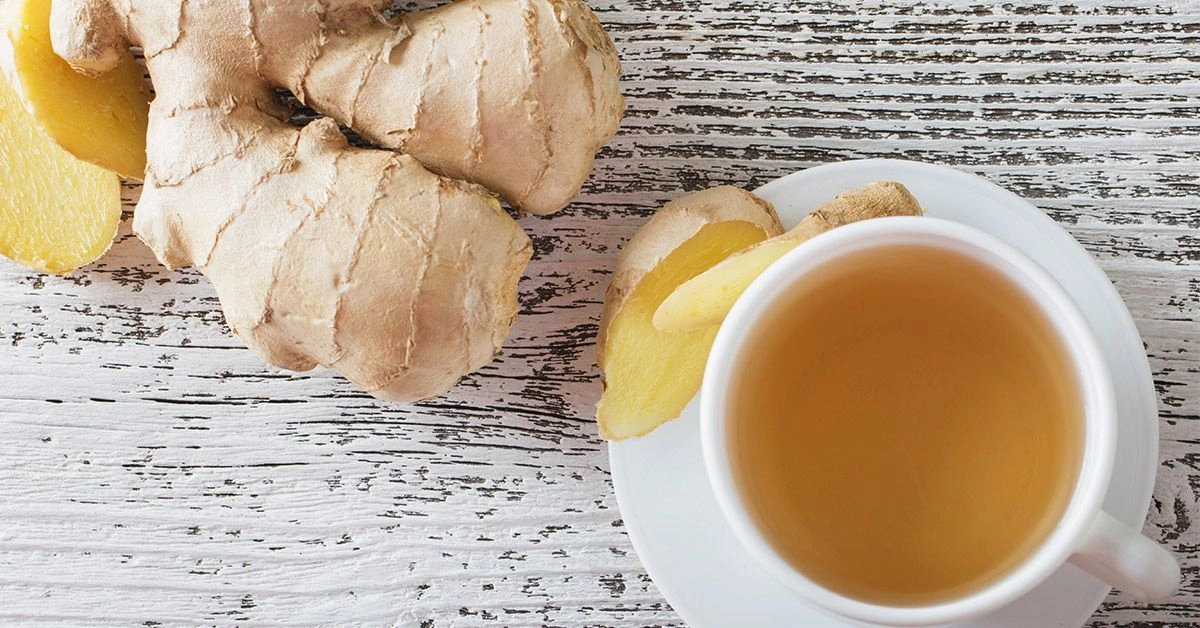Ginger, much like its cousin turmeric, has become widely popular because of its many health-promoting properties. In fact, it is ranked among the top 10 best-selling herbal supplements in the United States.cms.herbalgram.org/herbalgram/issue119/hg119-herbmktrpt.html

While ginger is most often used to calm indigestion, queasiness, and upset stomach, this pungent, fragrant root is also frequently used to soothe headaches and migraine.
Continue reading to learn how ginger can help ease headache symptoms and which forms seem to work best.
How does ginger work?
Ginger contains a naturally occurring oil that gives it both its distinctive taste and therapeutic effects. The active compounds in this oil — including gingerols and shogaols — possess anti-inflammatory and analgesic properties.ncbi.nlm.nih.gov/pubmed/23871076ncbi.nlm.nih.gov/pubmed/11710709 These constituents are also effective at reducing nausea and vomiting, symptoms commonly associated with migraine attacks.10.4137/IMI.S36273
Ginger extracts may also boost serotonin, a neurotransmitter implicated in migraine. Raising serotonin levels in the brain could help halt migraine by lowering inflammation and constricting blood vessels — a mechanism similar to that of prescription triptan medications.
What the research says
Several clinical trials have explored ginger’s effects in people who experience migraine. A 2018 trial found that combining a 400 mg ginger extract supplement with ketoprofen — a nonsteroidal anti-inflammatory drug — reduced migraine symptoms more effectively than ketoprofen alone.10.1177/0333102418776016
A 2014 trial reported that 250 mg of a ginger powder supplement reduced migraine symptoms roughly as well as the prescription medication sumatriptan.10.1002/ptr.4996
Other studies indicate that placing a gel containing ginger and the herb feverfew beneath the tongue at migraine onset can lessen both the intensity and duration of attacks.10.1111/j.1526-4610.2011.01910.x
What’s the most effective form of ginger to use on headaches?
Ginger is available in several preparations, including:
- capsules
- gels
- powders
- essential oil
- tea
- beverages
- lozenges
To date, only ginger capsules and a sublingual gel have been formally studied and shown benefit for migraine sufferers. Other forms haven’t been researched as thoroughly but might still be useful.
The form you choose may depend on your symptoms. For example, if nausea and vomiting accompany your migraine, swallowing a capsule may be unappealing. In that case, you could try rubbing diluted ginger essential oil on your temples or sucking a ginger lozenge.
Read on for details about various ways to use ginger for headache relief.
Take a ginger supplement
Most of the promising evidence for ginger’s effect on migraine involves supplements that contain ginger extract or dried ginger powder. Consequently, ginger supplements are the most likely option to relieve headache and migraine symptoms.
A common regimen is a 550 mg capsule taken at the first sign of a headache, which can be repeated once or twice if necessary. You can find ginger supplements in pharmacies, grocery stores, and online. Also consider reading about ginger for acid reflux if you are using ginger for digestive symptoms.
Although uncommon, some people taking ginger supplements experience mild adverse effects, such as:
- heartburn
- gas
- throat or mouth irritation
- diarrhea
- flushing of the skin
- rash
These effects are more likely at higher doses.
Apply ginger essential oil to your temples
Massaging ginger oil into the skin eases pain in conditions like arthritis and back discomfort, and it may also help reduce headache pain.
For a migraine or tension headache, gently rub a few drops of diluted ginger oil into your temples, forehead, and the base of the neck once or twice a day.
The scent of the oil may additionally help ease the nausea that often accompanies migraine. Place a drop of ginger oil on a tissue, gauze, or cotton ball and inhale, or add one to two drops into a warm bath or a steam diffuser.
Pure ginger essential oil is sold in pharmacies, supermarkets, and online. Avoid perfumed or imitation ginger-scented blends. Always dilute essential oil by mixing one to two drops of ginger oil into a tablespoon of a carrier oil before applying. Learn more about carrier oils.
Essential oil side effects and risks
Never apply undiluted ginger oil to the skin. Doing so can provoke irritation and, in some cases, severe skin reactions.
Even when diluted, some people may develop a skin reaction. Perform a patch test if you have had reactions to essential oils previously. If you are allergic to ginger spice, you may also be allergic to the oil.
How to do an essential oil patch test
To conduct a patch test, follow these steps:
- Place 1 to 2 drops of diluted oil on the inner forearm. Never use undiluted oil.
- Cover the spot with a bandage and wait.
- If you experience irritation, remove the bandage at once and gently wash the area with soap and water.
- If no reaction develops after 48 hours, the diluted oil is likely safe for you to use.
Suck on a ginger lozenge
Ginger lozenges usually contain small amounts of ginger powder or extracts. Research demonstrates that ginger can reduce nausea after surgery, during pregnancy, or from other causes, and it may also counteract migraine-related nausea.
Lozenges are especially handy when pills or liquids are unappealing. Try sucking a ginger lozenge at the onset of migraine-related queasiness.
Typically, one to two lozenges are used two to three times daily to ease stomach upset, but follow the product’s dosing instructions.
Ginger lozenges are available in pharmacies, supermarkets, and online.
Ginger lozenge side effects and risks
Most people tolerate ginger lozenges well, but some may experience an upset stomach or irritation, burning, or numbness in the mouth or tongue.
Rarely, an allergic reaction to ginger can occur. If you’ve reacted to ginger before, avoid lozenges.
Drink ginger ale
Sipping ginger ale during a headache or migraine may help lessen pain and soothe a queasy stomach. Limit intake to one or two cups per day.
When buying ginger ale, inspect labels carefully: many commercial brands contain high sugar levels and minimal actual ginger. You can also prepare ginger ale at home. One simple method is:
- Bring 2 to 4 cups of water to a boil in a saucepan.
- Add 1/4 to 1 cup of chopped or grated ginger and a sweetener such as sugar or honey to taste.
- Simmer for 5 to 10 minutes, then strain.
- Combine the ginger liquid with carbonated water. Add mint or fresh lime or lemon juice for extra flavor.
Ginger ale side effects and risks
Most people won’t have problems after drinking ginger ale, but consuming large amounts may cause mild side effects such as:
- heartburn
- belching
- irritation or burning in the mouth and throat
- diarrhea
- flushed skin
- rash
Brew ginger tea
Ginger tea is another pleasant option to help calm headache pain or reduce migraine-related nausea. Drink it at the first sign of a headache and, if needed, have another cup one to two hours later.

Prepackaged tea bags are sold in stores and online. You can also brew it yourself:
- Add sliced or chopped ginger to 4 cups of boiling water.
- Steep 5 to 10 minutes; longer steeping produces a stronger flavor.
- Remove from heat and sweeten or flavor with lemon juice, honey, or sugar. Serve hot or chilled.
Possible side effects and risks
Like ginger ale, ginger tea is generally well tolerated, though some people may experience:
- heartburn
- gas
- irritation or burning in the mouth and throat
- diarrhea
- flushed skin
- rash
These reactions are more likely with stronger brews or large amounts.
Add ginger to a meal
Incorporating ginger into your cooking is an easy way to benefit from its anti-inflammatory and analgesic properties. You can use fresh ginger or dried powder, keeping in mind their flavors differ slightly.
The chemical profiles of fresh and dried ginger are also somewhat distinct, yet both contain compounds that reduce inflammation and nausea.
Try adding fresh ginger to salads or using it in a garlic shrimp stir-fry. Ginger also pairs nicely with chicken soup, grilled salmon, and some baked goods like ginger snaps or cakes.
You can also explore tips for incorporating ginger into your morning routine.
Fresh ginger side effects and risks
Eating ginger rarely causes problems unless consumed in excess. Overconsumption may produce an upset stomach with heartburn and gas, and some people may notice a burning sensation in the mouth.
If migraine-related nausea makes eating unpleasant, alternatives such as sipping ginger ale or using a lozenge may be more tolerable.
Bottom line
Evidence supporting ginger for headaches is limited but encouraging. The strongest support is for ginger supplements, though other forms may also relieve headache pain and migraine-related nausea.
More isn’t always better with ginger — higher amounts raise the chance of mild side effects like heartburn and stomach upset.
If your headaches grow more frequent or severe, see your doctor for evaluation and appropriate treatment recommendations.
Also consult your physician or pharmacist before using ginger alongside other medications to ensure it won’t interact. Ginger can have a blood-thinning effect and may increase bleeding risk when combined with anticoagulant drugs.


















Leave a Reply
You must be logged in to post a comment.